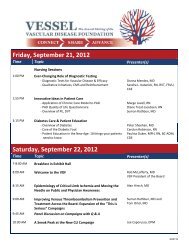V08-N04 - Vascular Disease Foundation
V08-N04 - Vascular Disease Foundation
V08-N04 - Vascular Disease Foundation
Create successful ePaper yourself
Turn your PDF publications into a flip-book with our unique Google optimized e-Paper software.
Peripheral Arterial <strong>Disease</strong> (PAD)<br />
Peripheral Arterial <strong>Disease</strong>, also known as PAD, is a common<br />
vascular disease caused by a gradual buildup of fatty<br />
deposits where the arteries become hardened and narrowed.<br />
This condition is referred to as atherosclerosis, commonly<br />
known as poor circulation or hardening of the arteries. The<br />
atherosclerotic process injures cells lining the blood vessels<br />
(endothelial cells) and causes a build-up of fat, white blood<br />
cells, and muscle cells, known as plaque, in the vessel wall.<br />
This condition can occur in any artery in the body.<br />
PAD gradually restricts blood flow to the legs and feet,<br />
which can cause muscle aches/pain and fatigue when walking.<br />
This pain is caused by the lack of oxygen getting to the<br />
muscles in your legs. PAD may lead to disability and<br />
decreased quality of life and, if severe, amputation. PAD is<br />
often a “silent” condition, producing no symptoms. As a<br />
result, PAD is under-diagnosed and under-treated. People<br />
who do experience symptoms, such as pain or cramping in<br />
the legs, often do not report them, believing they are a natural<br />
part of aging or due to another cause.<br />
Guidelines and data emphasize the importance of standards<br />
of care and the need to identify and treat PAD. In fact,<br />
PAD needs to be treated as aggressively as if you have had a<br />
previous heart attack or stroke as it represents the same atherosclerotic<br />
process. If you have PAD, you are four to five<br />
times more likely to have a heart attack or stroke.<br />
The standards of care or best treatment for PAD depend<br />
on a number of factors, including your overall health and the<br />
seriousness of the disease. In some cases, lifestyle changes are<br />
enough to halt the progression of PAD and manage the disease.<br />
Lifestyle changes include exercise, stopping smoking,<br />
and dietary changes. Sometimes, medications or procedures<br />
that open up the narrowed blood vessels are required to treat<br />
PAD. The most commonly prescribed medications include:<br />
an antiplatelet agent to make the blood less sticky and flow<br />
better, cholesterol-lowering medication, and maybe a bloodpressure<br />
lowering medication. If the person has diabetes, glucose<br />
levels need to be managed. Blood pressure, cholesterol<br />
levels, and blood glucose levels all need to be kept within<br />
normal values to meet the standards of care.<br />
Initial management should consist of modifying the vascular<br />
risk factors and aggressive medical treatment in the<br />
expectation that this will extend life, reduce the risk of progression<br />
of PAD, and improve the patient's functional status.<br />
Only after the best medical treatment has been instituted and<br />
given sufficient time to take effect should endovascular or<br />
surgical intervention be considered by your physician.<br />
The best medical treatment is beneficial even in patients<br />
who eventually need invasive treatment, as the safety, immediate<br />
success, and durability of intervention is greatly<br />
improved in patients who adhere to the best medical treatment.<br />
Talk to your doctor to find out if you have PAD and<br />
then follow up on treatment to Save your legs—Save your<br />
life!!<br />
What Is an ABI<br />
Getting the diagnosis is the first step. The diagnosis<br />
is made by measuring the ankle-brachial<br />
index (ABI) in conjunction with a medical history<br />
and a physical examination. The ABI is a<br />
noninvasive blood pressure measurement of<br />
the ratio of ankle systolic pressure to brachial<br />
(arm) systolic pressure, which quantifies the<br />
degree of arterial insufficiency. Your healthcare<br />
provider or doctor may perform the ABI<br />
in the office or send you to a vascular lab.<br />
The ABI should be checked if you are having<br />
reproducible pain in the calf, hips, or buttocks<br />
that comes on with walking and is relieved by<br />
rest. The ABI should also be checked if you<br />
are:<br />
1. < 50 years old with diabetes and one of<br />
the following risk factors: smoker, high<br />
blood pressure, high cholesterol level, or<br />
high homocysteine, have known heart disease,<br />
have had a stroke/TIA or renal artery<br />
disease;<br />
2. Age 50-69 with diabetes and a history of<br />
smoking; and<br />
3. If you are > 70 years old. The ABI should<br />
be rechecked if leg symptoms get worse or<br />
walking distance decreases. If it is normal,<br />
it should be rechecked in approximately<br />
five years.<br />
Talk to your health-care provider as to<br />
whether you may be a candidate to<br />
have your ABI checked.<br />
To receive VDF's free educational pamphlets on<br />
PAD, Focus on Walking and Focus on the ABI,<br />
please contact our office at 866.PAD.INFO<br />
(866.723.4636) or by e-mail at info@vdf.org.<br />
About the Author: Marge B. Lovell, RN, CCRC, CVN is a<br />
Clinical Trials nurse in the Division of <strong>Vascular</strong> Surgery at London<br />
Health Sciences Centre and Chair, P.A.D. Coalition.<br />
Keeping in Circulation • www.KeepingInCirculation.org • 888-VDF-4INFO<br />
5







